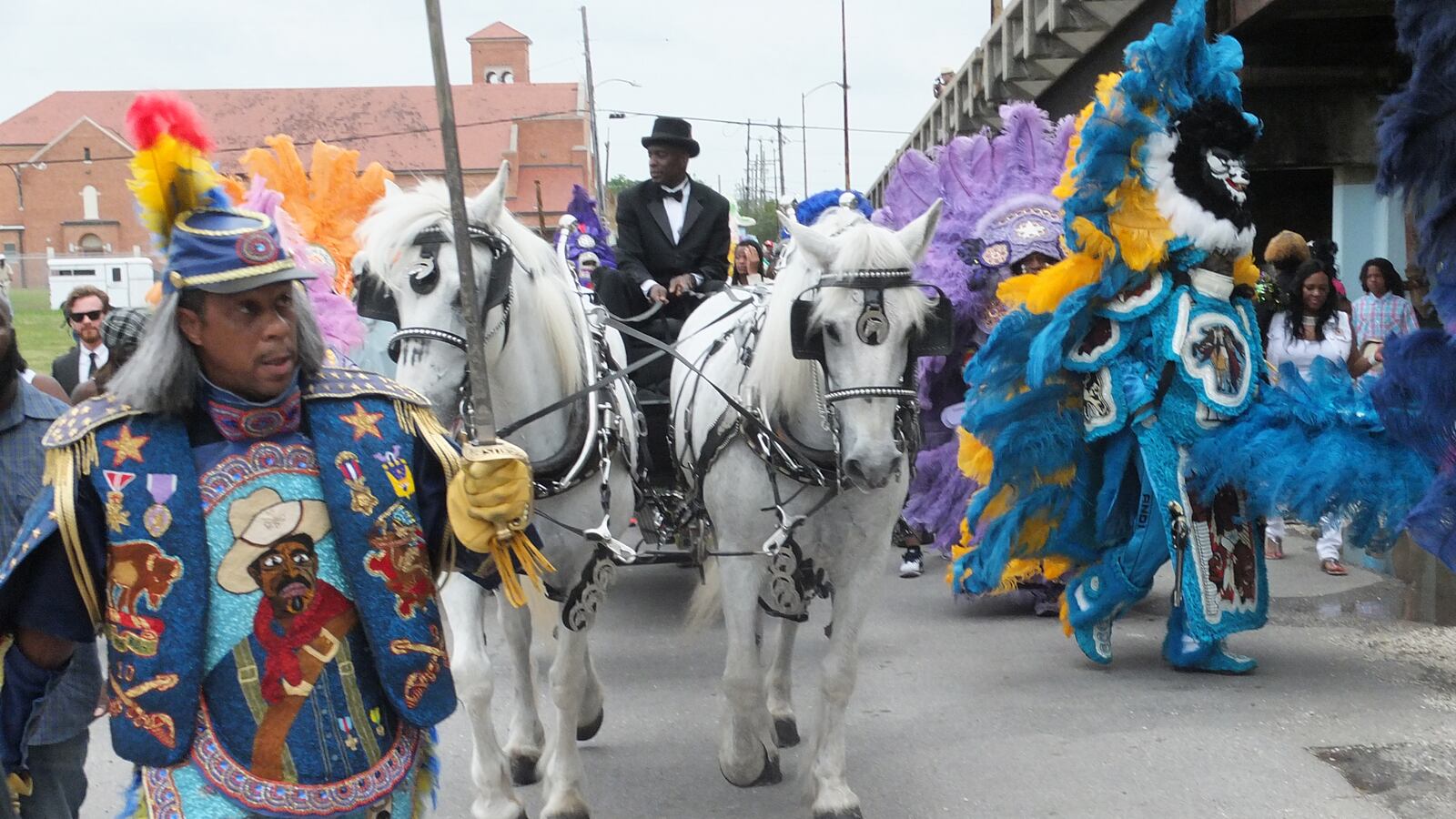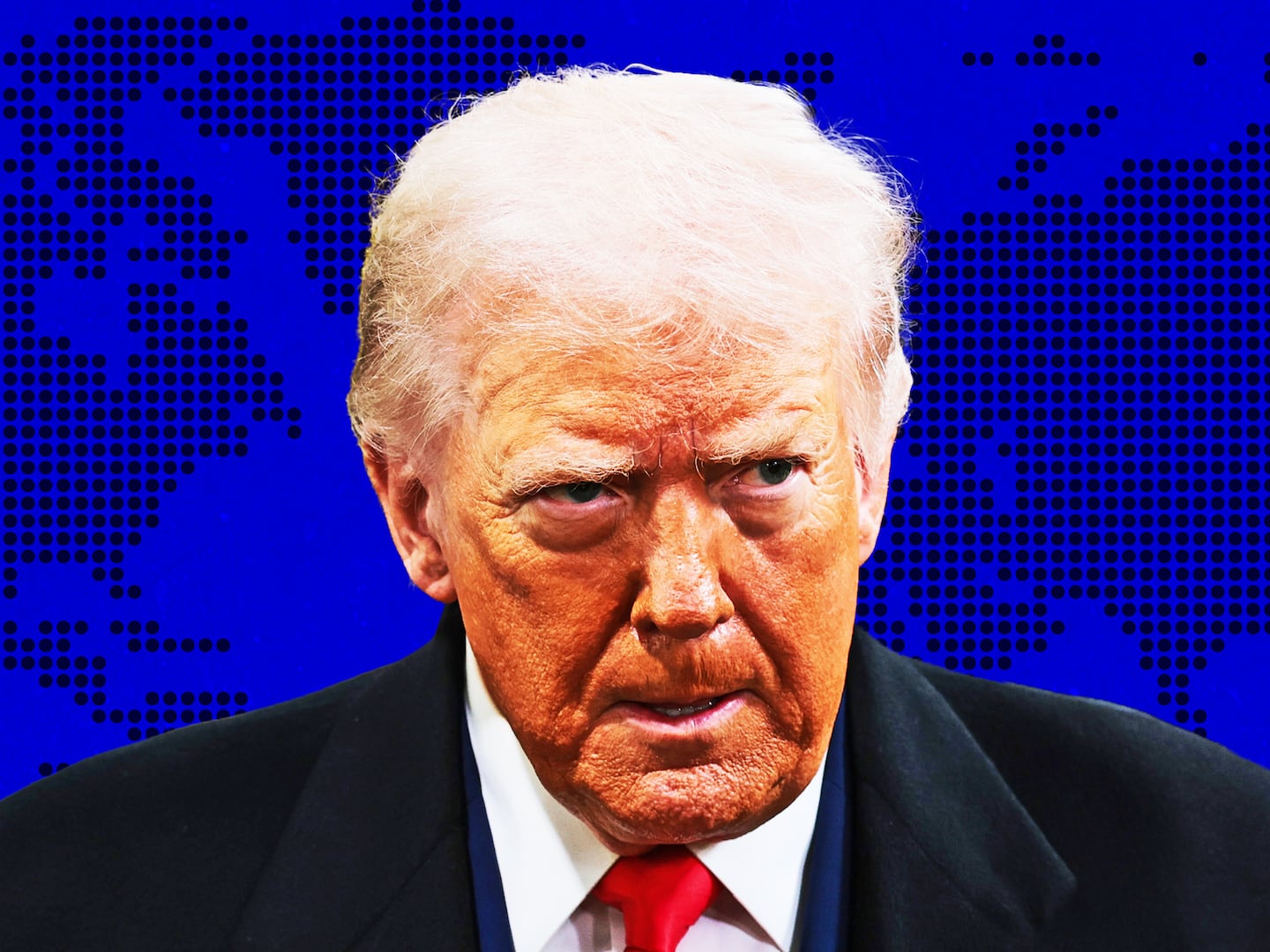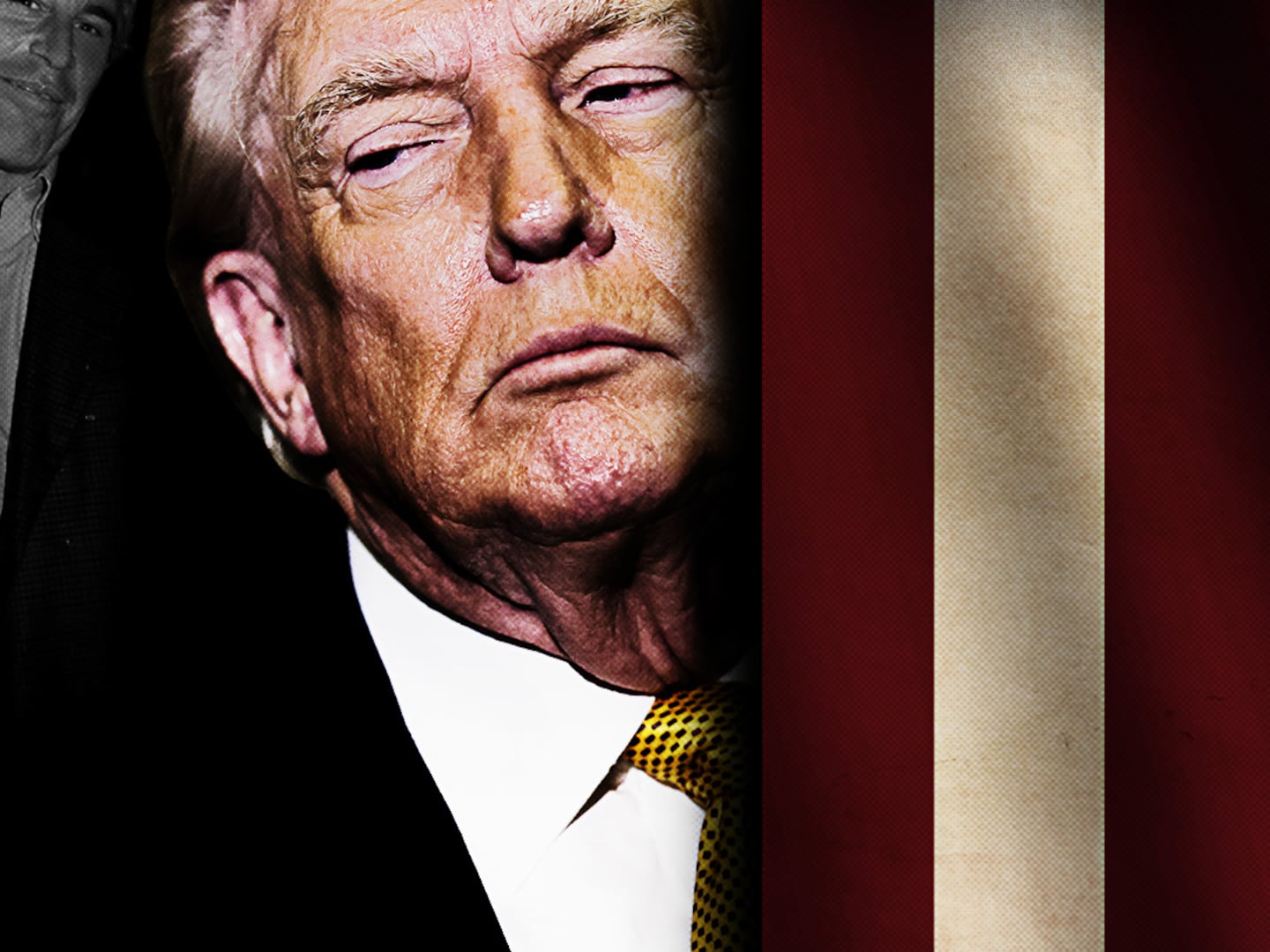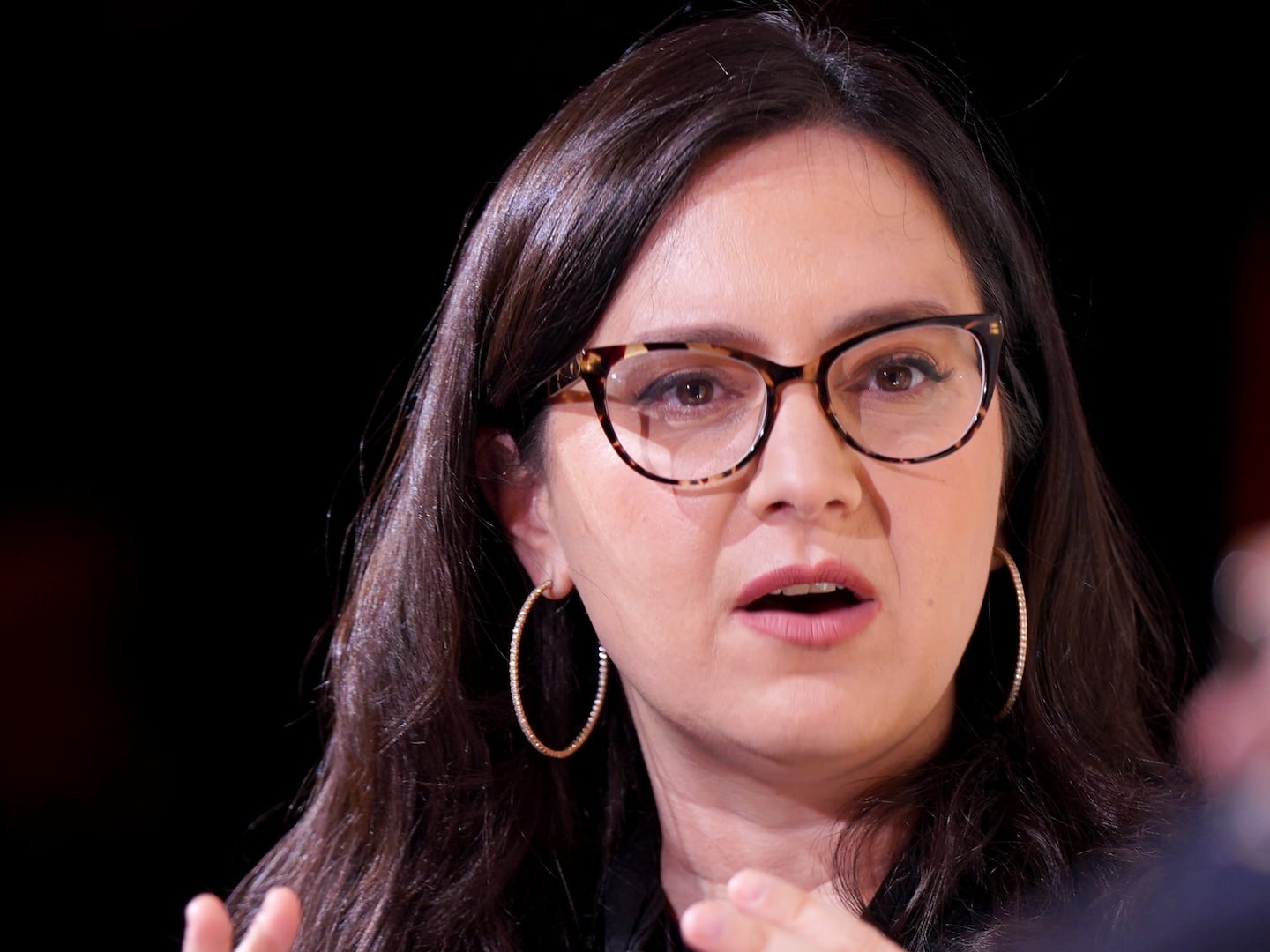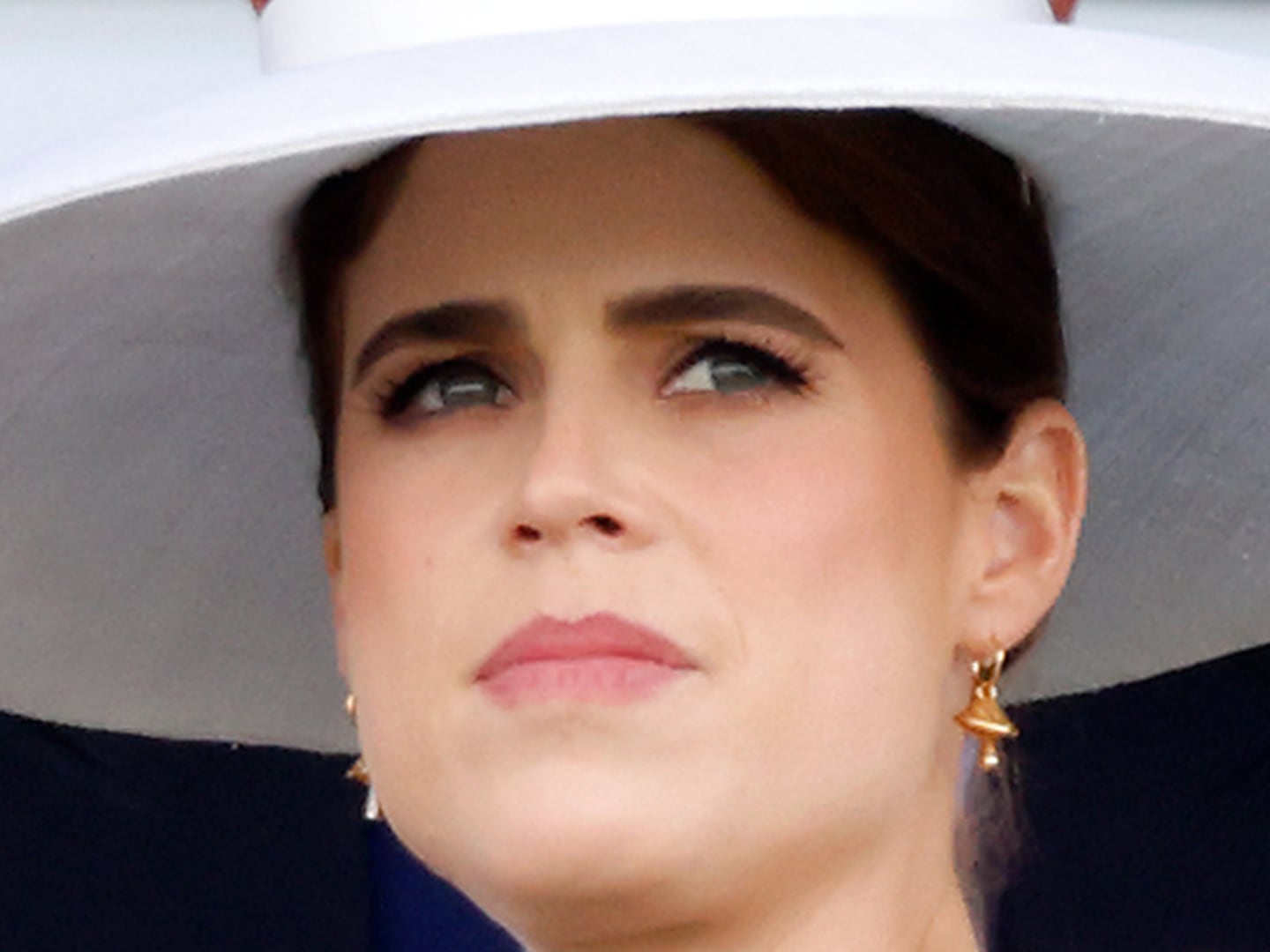When the pallbearers carrying Larry Bannock’s casket came down the steps from New Orleans’s City of Love Church last Saturday, 15 Mardi Gras Indians, their many-feathered costumes shimmering in the noontide light, sent up a roar: “Biggg Chieffff!
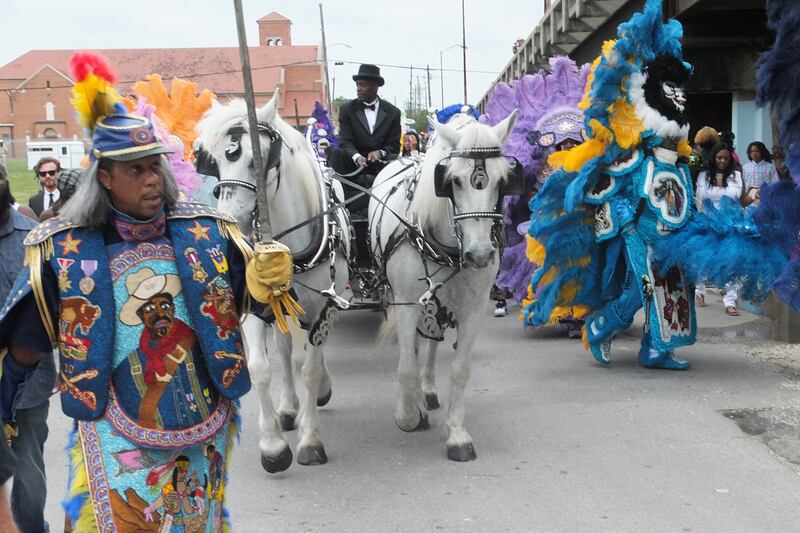
The words reverberated through the crowd of 300 people—Big Chief! Big Chief!—in homage to Bannock, a lionized figure in the urban warrior culture of working-class black men who sew the dazzling costumes and parade each year on Carnival day in winter and for selected events through late spring.
As family and loved ones followed the preacher behind the casket, Indians from Bannock’s Golden Star Hunters joined men from other gangs—the Wild Tchoupitoulas, Mohawk Hunters, Yellow Pocahontas and White Cloud Hunters. Oblivious to the heat, swaying in their costumes, thrumming tambourines, they began singing as the pallbearers hoisted the casket into an antique, horse-drawn hearse provided by the Charbonnet-Labot-Glapion Funeral Home.
We are In-diannns Inn-diannns Indians of the nation The whole wide creation Oh how I love to hear Them call My Indian Red
Kidney dialysis had forced Bannock to stop parading several years ago; but as an Indian costume artist and bard of the tradition, he held sway in Gert Town, the impoverished enclave where he was raised by an aunt and stepmother. A burly man who didn’t mince words, he had a forbidding persona that made the wrong people keep their distance.
“No man will ever love me the way you did,” his adopted daughter, Cymonde Ford, 33, said in a tribute during the church service.
“I realized after bringing a few guys around, you would give them a really hard time and showed every last one of them your gun collection. I thought maybe I should give you a little more time to accept my dating.”
On Saturday, April 27, Bannock got on stage at the New Orleans Jazz and Heritage Festival and sang for the last time with the Golden Star Hunters, the tribe he led for more than 30 years.
Three days later, the 66-year-old Bannock expired of congestive heart failure and complications from diabetes. He had just returned home after an outpatient procedure, said longtime companion Rhonda Ford, Cymonde's mother.
A welder by trade, he worked at Avondale Ship Yard and on a crew that in the mid-’70s helped finish the Louisiana Superdome. But it was the intricate, beaded designs he sewed into the breastplates and back patches for his lush, feathered outfits that made Larry Bannock a renowned folk artist. His costumes were exhibited at the Smithsonian Institution and St. Louis Museum of Art, among other high-end venues.

“We form a percussion circle and sing songs about heroes in our community, and people who have passed,” he said in a 1984 PBS interview. “We’re remembering them. This is what keeps Mardi Gras going.”
He elaborated on the wellsprings of the tradition in an interview with me in 1989 for a Times-Picayune article.
“It’s a proud culture and it symbolizes to me the paying respects of the black and the red man,” Big Chief Bannock said.
He sat in the living room of his shotgun house in Gert Town that day, a shaft of winter light suffusing the maze of feathers, thread, needles, and ribbon. “It’s our job to bring the culture out,” he said, rubbing the yellow ostrich plumes for his headdress like silk between his fingers.
Discussing the Spy Boy, who scouts ahead for the Big Chief to warn of rival tribes nearing the turf of a given gang, Bannock broke into song:
I’m the Spy Boy that walked through the graveyard Kicking over tombstones I’m the Spy Boy jumped the St. Louis Cemetery fence Barked at thunder Roared at lightning Made death wonder! When you meet me that morning You better step aside. A lot of men didn’t, A lot of men died.
City of Love Church lies a block behind a huge Costco shopping outlet that opened last year, igniting commercial life in a large urban mall that was wrecked in the 2005 flooding that followed Hurricane Katrina. The area is coming back to life; but the streets behind the Costco have crevices and deep gouges.
The church faces two-lane Palmetto Avenue and a long canal that only floods in monsoon downpours. A cobalt sky greeted the mourners filing out of the church, about 150 of whom melded with the crowd of onlookers who had gathered, riveted at the sight of Indians, waiting to follow the funeral.
The crowd numbered about 450 as the mortuary attendants secured the casket inside the glass-paneled buggy and carefully fastened an enormous shroud of yellow plumes and feathers atop the hearse for Larry Bannock’s final ride.
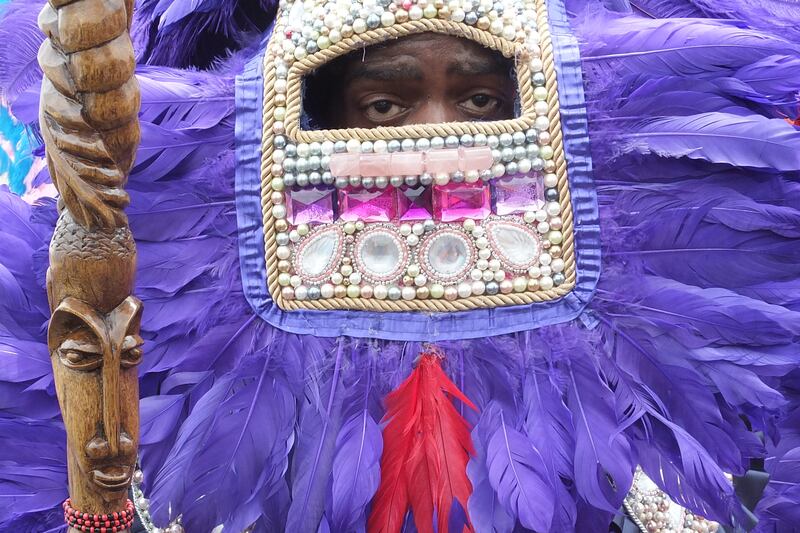
“Bigggg Chieffff!” cried one of the Indians.
“Myyy big chief!” boomed another.
A man in a yellow T-shirt walked behind the hearse, his back bearing the logo Ain’t No Star Like A Shining Star.
A group of young brass band musicians, wearing shorts and jeans and T-shirts, carried the “Indian Red” melody into an uptempo march behind the booming bounce of the bass drummer.
But the rutted street that bore the scarification lines of the 2005 flood made it difficult for people in the second line to dance, so they jostled along in stutter steps to avoid falling face forward.
The driver in his black suit, white shirt, and black tie shook the reins, coaxing the white horses ahead. They pulled the elegant wagon on a slow pace along for a block and then made a U-turn beneath the Palmetto overpass.
The pounding drums, rubato horns and shaking tambourines boomed off the steel girders like an echo chamber as the horses emerged in the sunlight. A policeman stopped traffic on Palmetto for the cortege and second line to pass, and in a better street, people broke out dancing.
Three-story apartment buildings built since Katrina lined the right side of the avenue. The music tides drew people in clusters on balconies, porches and street corners, black folk waving to friends, people twirling white handkerchiefs to signal a soul released from earthly ties.
“Go head on, Larry,” called a lady from a balcony.
“Big Chief don’t never bow down!” yelled a man.
An Indian in an orange outfit swaggered up behind the hearse, his costume catching the shafts of sunlight like a bush burning on concrete.
Behind him came a woman in a suit of bright turquoise feathers and plumes with red fringe, meandering along in no special hurry as people absorbed the flurry of bluish-green and her two little girls, dressed in identical turquoise outfits, marching with stoic resolve.
A man in a wheelchair, presumably one of the gunshot victims who follow the parades of Social Aid and Pleasure Clubs that are periodically marred with violence, pushed hard, keeping up with an Indian from the Mohawk Hunters who carried a saber and wore a blue vest like a Union jacket from the Civil War. His shoulders bore the logo Buffalo Hunters and the feather-fringed apron displayed a black soldier in military blue with a chest of ribbons on horseback, rescuing an Indian woman clutching a baby with an African face.
Themes of armed resistance and solidarity between Africans and Indians abounded on the many costumes.
A man pulled an ice chest on wheels, selling water for a dollar a bottle.
The Indians have had historic tensions with the New Orleans Police Department, though not as bad as 1930 when a cop took a spear to the neck and the city council issued an ordinance forbidding Indians to bear arms. History does not record whether it was enforced, though Indians and NOPD kept on clashing.
But for the Big Chief’s funeral, policemen on motorcycles halted traffic at the major intersection of Carrollton and Washington avenues. Several motorists opened their doors, standing by their cars, taking pictures on cellphones as crowd moved slowly across Carrollton.
A woman dressed in white bloomers, white stockings, a white blouse and matching umbrella sashayed across the avenue, twirling the tiny parasol, winking at one and all. She was professing as a Baby Doll, a tradition begun by hookers in the era of the Storyville bordello district who paraded in Mardi Gras seeking money for their garters; the federal government shut the district in 1917 as a threat to Navy sailors’ health. In the decades that followed, respectable Creole mommas and auntees cleaned up the Baby Doll tradition by parading in a satire of prostitutes.
Another man in a wheelchair crossed Carrollton Avenue with the human traffic.
A man walking slowly, with a cane, followed him.
The most spectacular Indian appeared to be a woman, wearing a suit of royal blue feathers and plumes, the face covered like an African mask with a mere horizontal slit for the eyes, the back of the costume a beaded image of an African women in a tiara of cowry shells, a long green dress and rising bubbles of many colors at the edge to convey a sense of the female figure in movement.
Palmetto becomes Washington Avenue after it crosses Carrollton and approaches the campus of Xavier University.
One block to the right lies Gert Town. The crowd trailed the hearse into the neighborhood where Larry Bannock lived his life.
The cracked, creased and pockmarked streets again made dancing harder. The sun beat down as the procession halted behind the parking lot for Pep Boys, a repair garage.
The buggy hearse stopped.
The funeral staff moved the coffin into a motorized hearse.
People touched the yellow feather shroud, singing “Indian Red” as the transfer of the coffin to the vehicle was done.
Then the hearse drove off.
As the crowd scattered a man and woman walked toward the Costco.
“Larry was a man,” said he.
“Larry loved that lul girl,” said she.
“Larry stood his ground.”
“That’s right. And Larry knew how to sew.”
Jason Berry’s books include Up From the Cradle of Jazz, a music history, and a novel, Last of the Red Hot Poppas.

